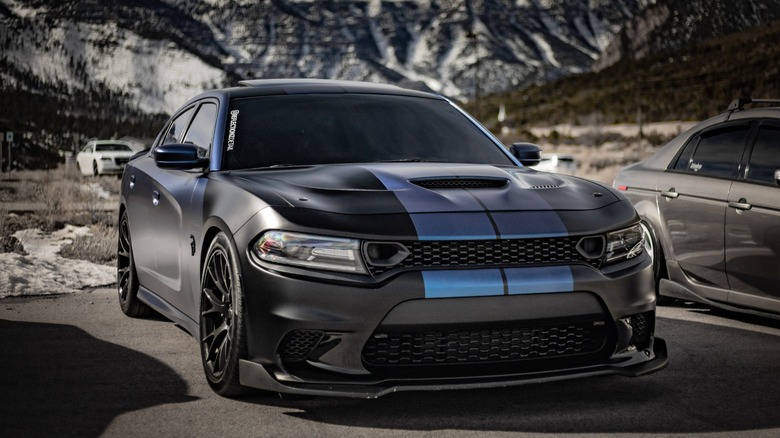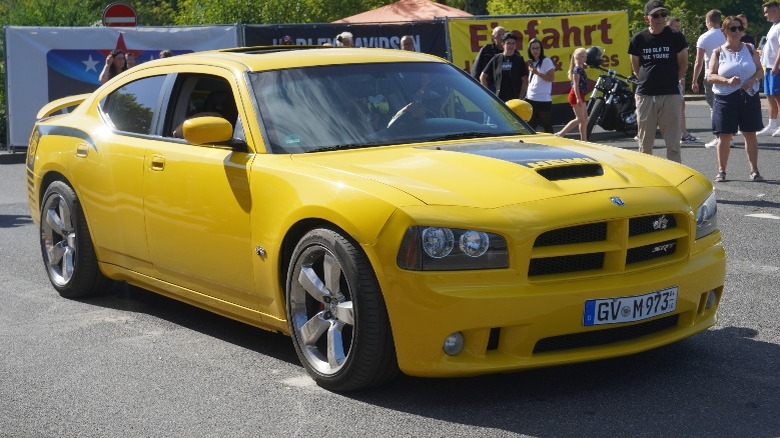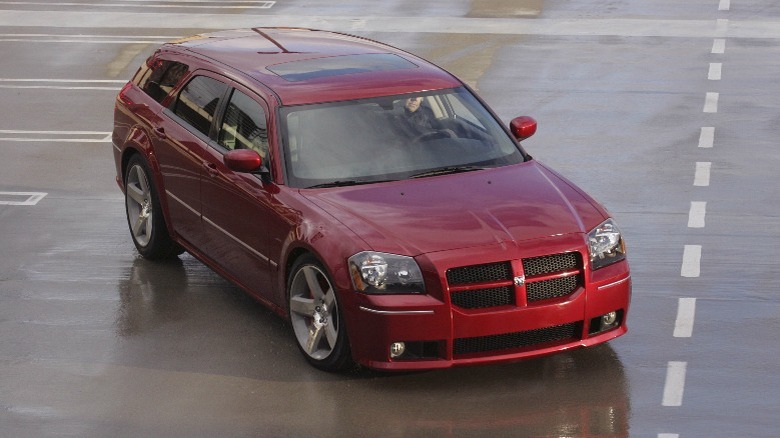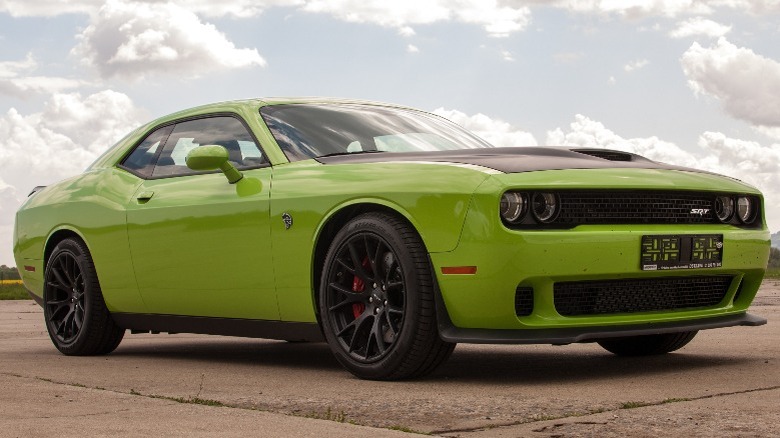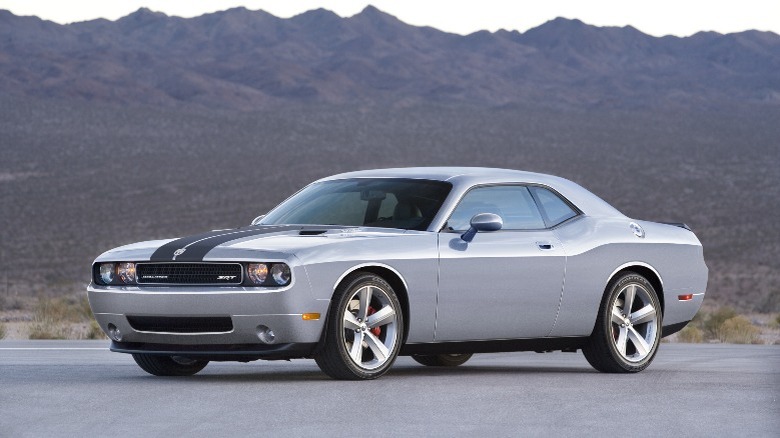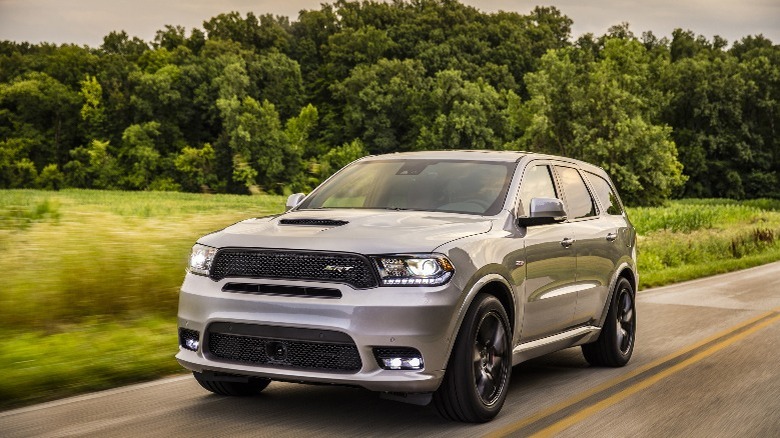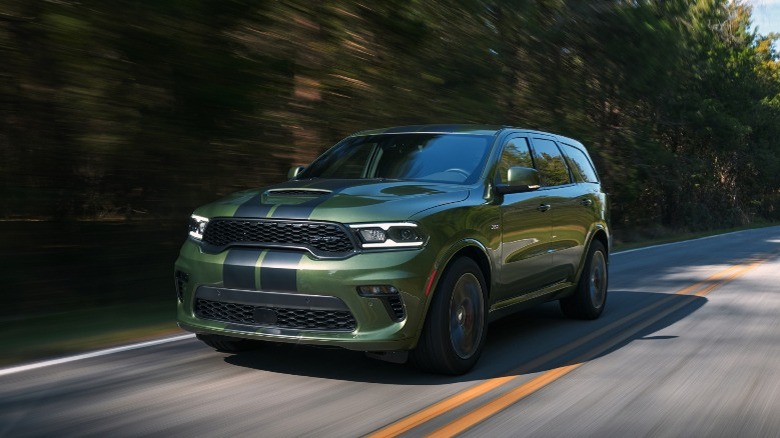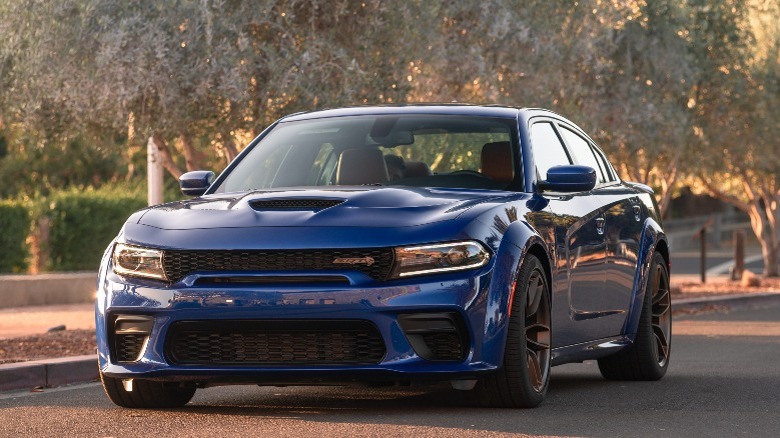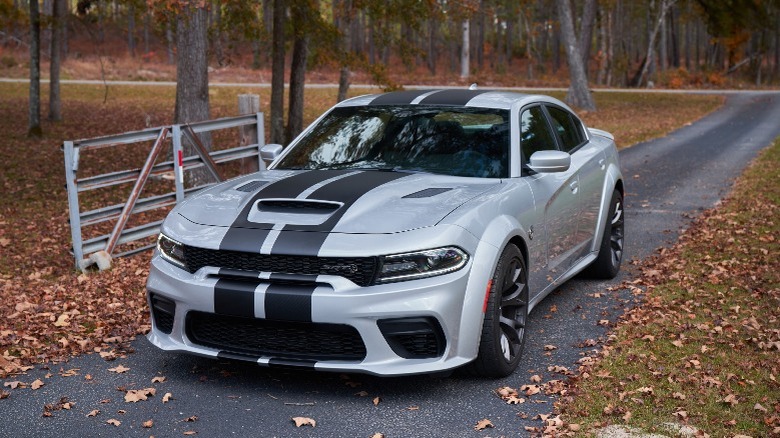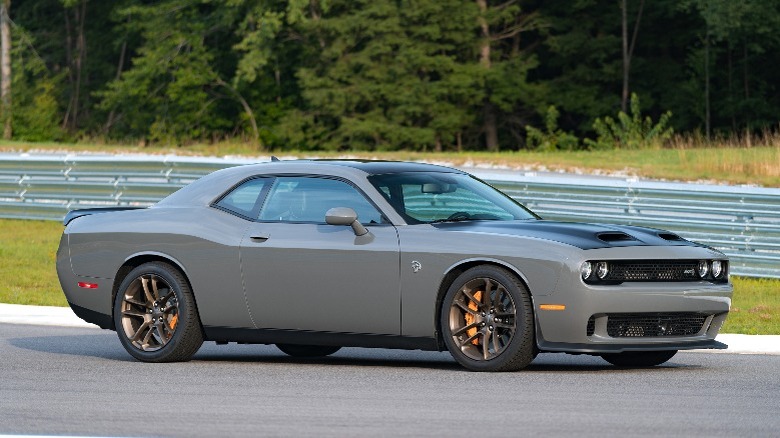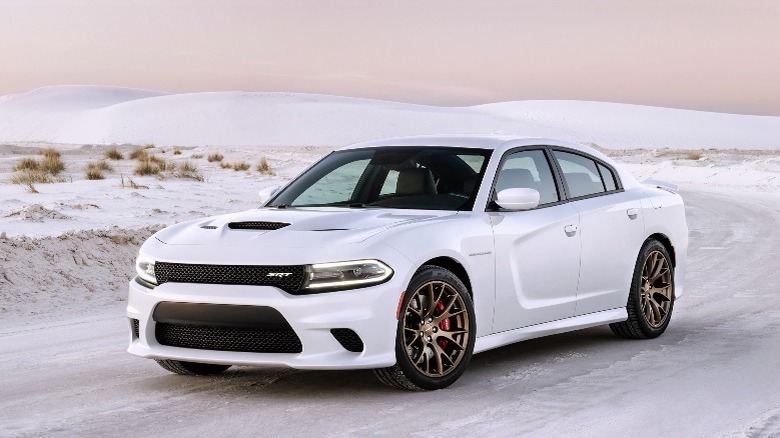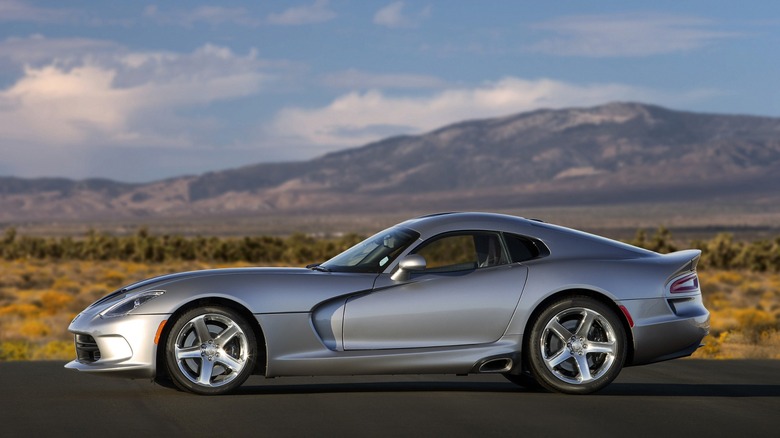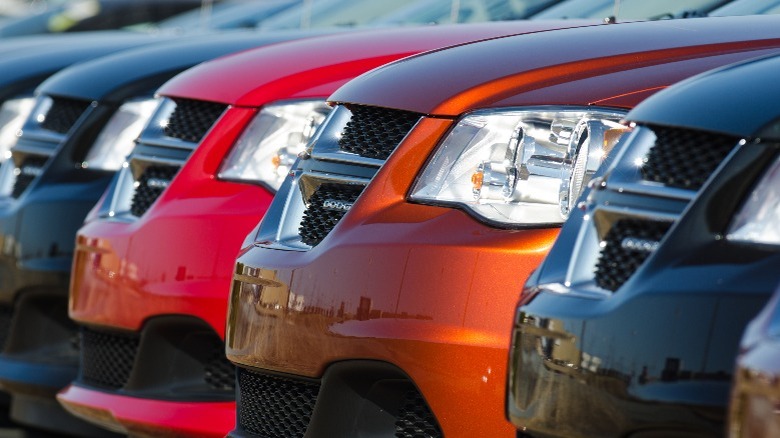11 Of The Fastest Dodge Cars Ever Made, Ranked By Top Speed
Dodge has come a long way for an automaker. Starting out in Detroit as a bicycle business owned by the Dodge Brothers in 1901 (whose story is told in Charles K. Hyde's book "The Dodge Brothers: The Men, the Motor Cars, and the Legacy"), today, it's one of the best-selling automakers in the U.S. The American automaker understood exactly what the MOPAR world was looking for – affordable power-packed vehicles – and made it happen. As a result, Dodge cars became top contenders on drag strips, race tracks, and even curvy roads.
Speed comes in different forms for Dodge vehicles. SUVs, sedans, coupes, and even station wagons get to put up impressive numbers on the board. Whether you prefer going from 0-60 mph in under four seconds or hitting 150 plus miles per hour on a barren back road, you can do it in any of the Dodge family of vehicles.
Here are 11 of the fastest Dodge cars ever made, ranked by top speed. This list is based off of Dodge's speed metrics on the cars alongside expert reviews.
11. 2008 Dodge Charger SRT8 (150 mph)
In the mid-1960s, the first Dodge Chargers hit the roads as a response from Chrysler to General Motors. GM's Chevy, Pontiac, and Oldsmobile muscle cars had been turning heads on the streets and out-selling their competitors. Dodge released the Charger, a coupe with a fastback roofline, to compete with them, making it stand out. Fast forward to the 2000s, DaimlerChrysler, the parent company of Dodge at the time, switched up and transformed the Charger from a coupe to a sedan. A lot more came with this change, most notably, the shift of focus from style and design to performance – with the Dodge Charger SRT8 leading the charge.
Of the six trims available on the 2008 Dodge Charger, the SRT8 sits at the top of the lineup, with a drivetrain that clearly sets it apart from the rest of the pack. For one, the SRT8 is fitted with a 6.1-liter HEMI V8 engine that churns out 425 horsepower and rockets the car to a top speed of 150 mph. None of the other trims pack this much raw power under the hood. But the Daytona R/T trim does come a little bit close, producing up to 350 horsepower with its 5.7-liter V8 engine. Even at that, the SRT8's engine is specially modified, made by Chrysler's Street and Racing Technology group, which is a group that handles the engineering of performance and power-focused Dodge cars.
10. 2006 Dodge Magnum SRT8 (169 mph)
In the world of speed and performance, sedans and coupes often take the show – barely leaving any room for SUVs. Yet, the 2006 Dodge Magnum SRT8, one of the coolest American station wagons, begs to differ. With ample seating and cargo space, this five-foot-long wagon station can reach 169 mph on a straight road. Alongside its top speed, it also puts up impressive figures on the quarter-mile mark, nailing it in under 13.1 seconds. It's an all-in-one family hauler and speedster; a muscle wagon. At the time of the Magnum SRT8's production, Mercedes Benz still owned Chrysler.
As a result, we can attribute its five-speed automatic transmission system, which was a big deal in the early 2000s, to the German automaker. This transmission played a significant role in pushing the 6.1-liter HEMI V8 engine of the Magnum SRT8 to the max.
The engineers of the Magnum SRT8 also put a lot of work into its handling and control, maybe because of the brute force the station wagon packs, specifically, the 425 horsepower racing through the engine. There were SRT-tuned dampers for reliable handling when driving at high speeds and large anti-sway bars for reduced body roll when cornering in the Magnum. Not to talk about the brakes designed by Brembo for superior stopping power. For a station wagon, these high-performance specs are unusual, driving home the fact that DaimlerChrysler was truly going for a muscle wagon with the Magnum SRT8.
9. 2018 Dodge Challenger SRT Demon (168 mph)
A 2018 Dodge muscle coming this early in our list might be a shocker – the SRT Demon is that — but there's good reason for it. Some performance cars are built for short bursts of speed, while others are built for rapid acceleration. The 2018 Dodge Challenger SRT Demon isn't limited to one but checks both categories. That leaves us with one drag-strip-ready coupe that can also dominate the race tracks.
It goes from 0-60 mph in 2.3 seconds, hits the quarter-mile mark in 9.65 seconds, and reaches a top speed of 168 mph. However, that's not all there is to Demon's top speed. Road and Track adds that the Demon's top speed could go as high as 211 mph, with some upgrades, of course.
We're not talking about some tuning or performance modifications here. You just need to remove the speed limiter on the Demon and change its drag radial tires for ones designed for much more speed. You see, the drag radial tires on the SRT Demon were intended to give it unparalleled grip off the line to reduce wheel spin, which is good for drag racing. While it does limit the top speed of the car, the Demon's exclusive Demon Crate contains just all anyone needs to unleash the full speed of the one-of-a-kind muscle.
8. 2009 Dodge Challenger SRT8 (170 mph)
With the 2008 Dodge Challenger SRT8 selling out all 6,400 production models, you'd think the 2009 version would be an even bigger hit. Sadly, the global financial crisis had other ideas. Automakers had to cut prices and performance on their performance vehicles. But this didn't reduce Mopar fans' expectations for the Dodge Challenger series, who had been keenly anticipating the 2009 model after its predecessor's success. Similarly, Dodge wasn't looking to let them down.
Among the range of grades of the Challenger, including a V6 option, top-of-the-line is the SRT8 trim. Under the hood, you have a 6.1-liter Hemi V8 engine with 425 horsepower, allowing it to go up to 170 mph in a straight line. For its looks, the 2009 SRT8 took much after the 1970 Dodge Charger, especially the front fascia. From the identical dual-pair headlamp design to the hood air vents, it almost looked like the pony car from the '70s. Possibly an effort by Dodge to reel in buyers looking for a modern take on the retro icon. Still, the SRT8 from 2009 did look different in its own manner. It had a much fuller and lower-to-the-ground body than the '70s Charger.
7. 2019 Dodge Durango SRT (180 mph)
After discontinuing the production of the Dodge Ramcharger in 1993, Dodge left the SUV market for a brief period. The Ramcharger was a top contender in the SUV market, but it wasn't a wallet opener. This may have been because of its full-time all-wheel-drive drivetrain, which took a toll on its fuel economy.
It was unique in its own manner, churning out 190 horses at best, even with its unique liftback. After five years in the workshop, Dodge returned to the SUV market with the Durango, a three-row SUV with dedicated luggage space putting up the same top speed as two-row SUVs. It was quite a return to the SUV market for the American Automaker. The first-gen Durango was built on the same platform as the Dodge Dakota pickup truck, so much for taking time off the market.
It wasn't until the second and third generations that we started seeing a distinct Durango. This brings us to the 2019 Durango SRT grade, which put up impressive performance numbers. It hits the quarter-mile mark in 12.9 seconds, goes from 0 to 60 mph in 4.7 seconds, and rockets down a barren back road at 180mph.
6. 2021 Dodge Durango SRT Hellcat (180 mph)
While there were expectations that the 2021 Dodge Durango would feature entirely new interiors and exteriors, it only got a facelift. The global pandemic might have played a role in this. But for a mere facelift, Dodge put in some work. For one, the hood and front fascia were designed for much more airflow intake. Then, the signature Dodge dual-pair headlamp design on the Durango now featured LED lights around them.
The top speed of the 2021 Dodge Durango SRT isn't much to talk about, however. Coming in at the same 180 mph top speed as the 2019 model, it didn't go any faster on a straight road. However, it packed a lot more force under the hood. It's equipped with a 6.2-liter HEMI V8 SRT Hellcat engine, which cranks out 710 horsepower, packing 235 more horses than the 2019 model. Then again, it's not just an SRT grade but an SRT Hellcat, elevating the performance to a new level.
5. 2020 Dodge Charger SRT Hellcat Widebody (196 mph)
From here on out, it's all Hellcats and Vipers. So, it's essential to know what the Hellcat is all about. Basically, it's Dodge's exclusive supercharged 6.2-liter HEMI V8 engine that produces a minimum of 707 horsepower and weighs over 4,000 pounds. Until 2021, only the Dodge Charger and Challenger nameplates had Hellcats. Now, you can find one in a Durango or Ram. Looking back at the field before Dodge started fitting their performance cars with Hellcats, it's not far-fetched to say the benchmarks for performance cars were far lower.
Why? Well, it was only after Dodge let the Hellcat loose that other competitors put their feet on the gas. To mention a few, we started seeing much more power-packed Mustangs and Camaros. With the Hellcat, the American automaker made supercar-like horsepower usually reserved for six-figure priced luxury and exotic cars accessible to everyday drivers.
With a Hellcat engine under its hood, the 2020 Dodge Charger Widebody rockets from 0-to-60 mph in 3.6 seconds and hits a 196 mph top speed, which was quite fast for a sedan in 2020. And with wider fenders and large 20-by-11-inch wheels to enhance grip and stability, the Widebody has a 0.96g rating on the skid pad, which makes it an all-in-one muscle machine.
4. 2021 Dodge Charger SRT Hellcat Redeye (203 mph)
After the debut of Hellcat engines, there was no turning back for the engineers and designers of Dodge performance cars. This led to the development of heavier yet power-packed engines capable of producing up to 1,025 horses. The 2021 Dodge Charger SRT Hellcat Redeye falls in this top muscle class. This muscle machine goes up to 203 mph on a barren back road. It also goes from 0-to-60 mph in 3.5 seconds and hits the quarter-mile mark in 11.5 seconds.
There's not much compromise in terms of explosiveness for acceleration. It's an all-in-one drag-strip-ready machine and a top-speed contender. This is all thanks to the Widebody vehicle kits and the unique 20-by-11-inch rims allowing wider tires. This way, you don't have to worry about getting from 0-to-60 mph quickly, dominating racetracks, or cutting corners quickly. This Dodge Charger also packs a punch with an engine that produces up to 797 horsepower.
3. 2019 Dodge Challenger SRT Hellcat (203 mph)
While Dodge might have let down fans of the limited-edition Challenger SRT Demon by sticking to its promise of producing only 3,300 units and nothing more, it gave them hope in the form of the 2019 Dodge Challenger SRT Hellcat. This model took much after the Demon with regards to what's under the hood, and not what's on top of it. Under the hood, it inherited a supercharged HEMI V8 engine, and to cool it off, Dodge fitted a dual-snorkel air extractor on the hood.
The 2019 Dodge Challenger SRT Hellcat didn't produce 840 horsepower like the Demon, but 123 horses less, coming in at 717 horsepower. A reduced horsepower, however, doesn't stop it from putting up impressive figures. On a straight road, it goes up to 203 mph with the help of Dodge's improved launch control tech. For one, the line-lock feature made tire smoking easier and improved the grip and traction of the tires.
2. 2015 Dodge Charger SRT Hellcat (204 mph)
The first time a Dodge crossed the 200 mph top speed mark with performance cars was in 2015, with the 2015 Dodge Charger SRT Hellcat. It was one of the fastest sedans in its production year, coming second in place to the Tesla Model S, which ran on an electric drivetrain.
How a 2015 model hits a higher top speed than models released six years after it might puzzle you.
It all goes back to the logic that some performance cars are engineered to dominate the drag strips with quicker 0-to-60 mph times and quarter-mile marks, while others are built to hit staggering top speeds. The consumer market isn't leaning towards higher top speeds either. The 2015 Dodge Charger SRT Hellcat hitting a higher top speed – 204 mph – than a 2020 Hellcat doesn't mean Dodge was taking their foot off the gas for their performance cars, but only repurposing them.
1. 2015 Dodge Viper SRT (206 mph)
Coming in at number one is a Dodge Viper sporting a V10 engine developed in collaboration with Lamborghini that goes up to 206 mph: the 2015 Dodge Viper SRT. Dodge's performance cars were putting up good numbers, both in sales and speed stats, so they thought, "why not take it to the next level?"
The result: Sports cars fitted with 8.0-liter V10 engines that could rocket 160 mph on a straight road and go from 0-60 mph in 4.2 seconds in 1992. This was a car so exciting, Chrysler actually partnered with Paramount in the 1990s to make a tie-in TV show called, appropriately, "Viper."
This car was faster than the leading contenders at the time, the Chevy Corvette and Porsche 911 Carrera 2. Fast forward to 2015, Dodge decided to close the curtains on the Viper after a 23-year production run to focus on producing performance sedans that were in much demand. However, they went out with a bang with the 2015 Viper.
First, to make it much more stable on the road, it featured more stability tech, such as an electronic stability control system and ABS. Then, under the hood, it packed an 8.4-liter V10 engine — a 0.4-liter upgrade from the first-gen models — that produces 645 horsepower along with 600 pound foot of torque. To crown it all, it goes from 0-to-60 mph in 3.5 seconds and hits a top speed of 206 mph.
Methodology
While it's easy to go with the top speed of cars acclaimed by the manufacturer, it's much more efficient to dig deeper into what's under the hood of a car alongside its background to verify its true top speed. Hence, speed metrics obtained from real-world tests in normal conditions reflect the reality of a car's true speed performance on the roads. The acclaimed top-speed manufacturers usually provide results from a car's performance on specially prepped roads.
On the other hand, speed metrics claimed by everyday car drivers may be much more accurate if not for the different factors that set in, such as mileage on the car and whether it has been tuned or its performance has been modified. With this in mind, we weighed in expert reviews and other data from trusted sources to curate the accurate top speed of each car. We also considered the history of each car, the conditions surrounding their production or release, and the performance of their predecessors.
